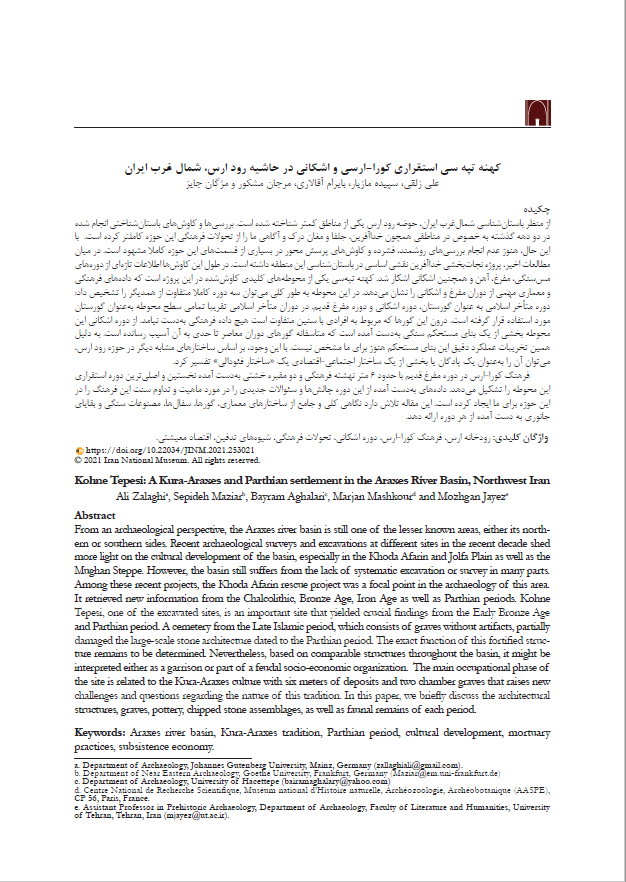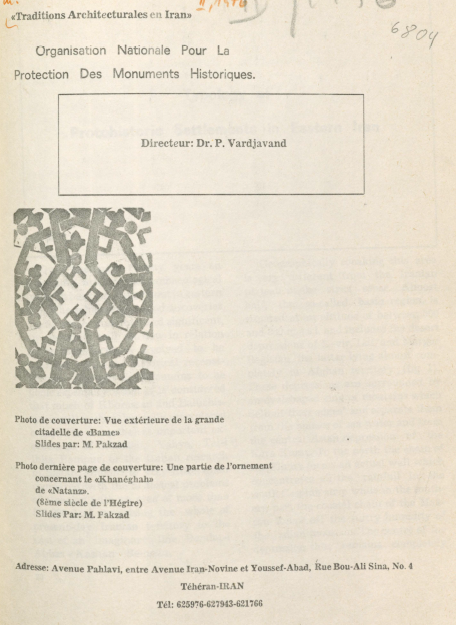Publications so far
0
| 1. |  | Zalaghi, Ali; Maziar, Sepideh; Aghalari, Bayram; Mashkour, Marjan; Jayez, Mozhgan: Kohne Tepesi: A Kura-Araxes and Parthian settlement in the Araxes River Basin, Northwest Iran. In: Journal of Iran National Museum, vol. 2, no. 1, 2021. (Type: Journal Article | Abstract | Links | BibTeX)@article{nokey,From an archaeological perspective, the Araxes river basin is still one of the lesser known areas, either its northern or southern sides. Recent archaeological surveys and excavations at different sites in the recent decade shed more light on the cultural development of the basin, especially in the Khoda Afarin and Jolfa Plain as well as the Mughan Steppe. However, the basin still suffers from the lack of systematic excavation or survey in many parts. Among these recent projects, the Khoda Afarin rescue project was a focal point in the archaeology of this area. It retrieved new information from the Chalcolithic, Bronze Age, Iron Age as well as Parthian periods. Kohne Tepesi, one of the excavated sites, is an important site that yielded crucial findings from the Early Bronze Age and Parthian period. A cemetery from the Late Islamic period, which consists of graves without artifacts, partially damaged the large-scale stone architecture dated to the Parthian period. The exact function of this fortified structure remains to be determined. Nevertheless, based on comparable structures throughout the basin, it might be interpreted either as a garrison or part of a feudal socioeconomic organization. The main occupational phase of the site is related to the Kura-Araxes culture with six meters of deposits and two chamber graves that raises new challenges and questions regarding the nature of this tradition. In this paper, we briefly discuss the architectural structures, graves, pottery, chipped stone assemblages, as well as faunal remains of each period. |
| 2. |  | Maziar, Sepideh; Zalaghi, Ali: Exploring Beyond the River and Inside the Valleys: Settlement Development and Cultural Landscape of the Araxes River Basin Through Time. In: Iran, iss. 59, pp. 36–56, 2020. (Type: Journal Article | Abstract | Links | BibTeX)@article{nokey,Geographical landmarks, especially rivers, have always played an important role in forming or hampering interplay between societies. In some cases, they act as a “communication route” and in some others as “obstacles”. In north-western Iran, it is possible that the Araxes River played such a decisive role by sculpting its surroundings. While our studies are not yet sufficiently adequate to understand the exact role of this river in different time spans, we can begin in some way to conceptualise its role in different periods. The Araxes Valley Archaeological Project (AVAP) was developed with the general aim of investigating settlement development from the fifth to the third millennium BC. Furthermore, studying the possible and probable routes of interaction, both inter- and intra-regional, between the Jolfa and Khoda Afarin plains and the southern Caucasus and north-western Iran, networks of contacts and exchange, and gaining a better understanding of the geographical characteristics of this area and its landscape were among our aims. In this article, the general history of occupation along this river is given to provide a preliminary database to understand the geographical and socio-political potential of this part in order to pursue more comprehensive studies in the future. |
| 3. |  | Tosi, Maurizio: Typology of Protohistoric Settlements in Eastern Iran. In: Vardjavand, P. (Ed.): Traditions Architecturales en Iran, vol. 2, Organisation Nationale Pour La Protection Des Monuments Historiques, 1976. (Type: Book Chapter | BibTeX)@inbook{nokey, |
2021 |
|
 | Zalaghi, Ali; Maziar, Sepideh; Aghalari, Bayram; Mashkour, Marjan; Jayez, Mozhgan: Kohne Tepesi: A Kura-Araxes and Parthian settlement in the Araxes River Basin, Northwest Iran. In: Journal of Iran National Museum, vol. 2, no. 1, 2021. (Type: Journal Article | Abstract | Links | BibTeX | Tags: Kura-Araxes, Parthian, Settlement structure)@article{nokey,From an archaeological perspective, the Araxes river basin is still one of the lesser known areas, either its northern or southern sides. Recent archaeological surveys and excavations at different sites in the recent decade shed more light on the cultural development of the basin, especially in the Khoda Afarin and Jolfa Plain as well as the Mughan Steppe. However, the basin still suffers from the lack of systematic excavation or survey in many parts. Among these recent projects, the Khoda Afarin rescue project was a focal point in the archaeology of this area. It retrieved new information from the Chalcolithic, Bronze Age, Iron Age as well as Parthian periods. Kohne Tepesi, one of the excavated sites, is an important site that yielded crucial findings from the Early Bronze Age and Parthian period. A cemetery from the Late Islamic period, which consists of graves without artifacts, partially damaged the large-scale stone architecture dated to the Parthian period. The exact function of this fortified structure remains to be determined. Nevertheless, based on comparable structures throughout the basin, it might be interpreted either as a garrison or part of a feudal socioeconomic organization. The main occupational phase of the site is related to the Kura-Araxes culture with six meters of deposits and two chamber graves that raises new challenges and questions regarding the nature of this tradition. In this paper, we briefly discuss the architectural structures, graves, pottery, chipped stone assemblages, as well as faunal remains of each period. |
2020 |
|
 | Maziar, Sepideh; Zalaghi, Ali: Exploring Beyond the River and Inside the Valleys: Settlement Development and Cultural Landscape of the Araxes River Basin Through Time. In: Iran, iss. 59, pp. 36–56, 2020. (Type: Journal Article | Abstract | Links | BibTeX | Tags: Armenia, Azerbaijan, Bronze Age, Caucasus, Chalcolithic, Georgia, Iron Age, Kura-Araxes, Landscape, Mobility, Neolithic, Settlement and subsistance systems, Settlement mobility, Settlement structure, Structure development)@article{nokey,Geographical landmarks, especially rivers, have always played an important role in forming or hampering interplay between societies. In some cases, they act as a “communication route” and in some others as “obstacles”. In north-western Iran, it is possible that the Araxes River played such a decisive role by sculpting its surroundings. While our studies are not yet sufficiently adequate to understand the exact role of this river in different time spans, we can begin in some way to conceptualise its role in different periods. The Araxes Valley Archaeological Project (AVAP) was developed with the general aim of investigating settlement development from the fifth to the third millennium BC. Furthermore, studying the possible and probable routes of interaction, both inter- and intra-regional, between the Jolfa and Khoda Afarin plains and the southern Caucasus and north-western Iran, networks of contacts and exchange, and gaining a better understanding of the geographical characteristics of this area and its landscape were among our aims. In this article, the general history of occupation along this river is given to provide a preliminary database to understand the geographical and socio-political potential of this part in order to pursue more comprehensive studies in the future. |
1976 |
|
 | Tosi, Maurizio: Typology of Protohistoric Settlements in Eastern Iran. In: Vardjavand, P. (Ed.): Traditions Architecturales en Iran, vol. 2, Organisation Nationale Pour La Protection Des Monuments Historiques, 1976. (Type: Book Chapter | BibTeX | Tags: Settlement structure)@inbook{nokey, |
